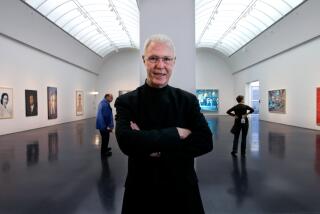Steven Lavine of Rockefeller Foundation to Head CalArts
- Share via
Steven D. Lavine, associate director for arts and humanities at the Rockefeller Foundation, has been named successor to Robert J. Fitzpatrick as president of the California Institute of the Arts.
The appointment was announced Tuesday by Jon B. Lovelace, chairman of the Valencia institution’s board of trustees.
Lavine, who holds a doctorate in English and American literature from Harvard University, will assume the post in late June. He will replace Nicholas England, who has served as interim president since Fitzpatrick left the school last August to become president of Euro Disneyland, a $2-billion resort and entertainment project to be built outside Paris.
Amid a fanfare of African drum music and dance, and a crowd of about 400 cheering CalArts students, faculty and staff, Lovelace officially welcomed Lavine to the 19-year-old institution, one of the foremost professional visual and performing arts schools in the nation.
Lavine, as one of three finalists for the job, “was the one candidate who had the combination of ability, talent, vision and enthusiasm to lead CalArts into its next phase of its growth and development,” Lovelace said. He did not name the other finalists.
“I want to be certain that CalArts embraces all the strong art traditions of the world, and to take part in the continued life of the remaking of all of those arts,” the 40-year-old Lavine said.
He added in an interview that he has not yet established a specific agenda for his presidency. However, he said he wants to continue to expose CalArts students to the myriad art forms of Los Angeles’ diverse cultural makeup and to continue other efforts of his predecessor.
Lavine said he hopes to follow Fitzpatrick’s dictum that CalArts “take a large part of the responsibility for the cultural life of Los Angeles. I hope we’ll carry that on--perhaps not with things as flashy as (Fitzpatrick’s), but with real energy and by engaging Los Angeles’ working artists, its established cultural institutions and its expanding minority arts institutions,” he said.
Fitzpatrick attracted international attention as director of the pioneering 1984 Olympic Arts Festival and the 1987 Los Angeles Festival.
CalArts was founded by the Disney family based on Walt Disney’s vision of a community of the arts in which the visual and perfomring arts could flourish in a creative educational environmnent.
But CalArts’ early years were marked by controversy. The school received notoriety for allegations of sexual permissiveness, theft, nude swimming and a faculty member removing his clothes at a meeting. In addition, there were political tensions between the school and the conservative board of trustees.
At one point, the Disneys grew worried about the school and approached both Pepperdine University and USC about a possible merger.
When Fitzpatrick began at the financially troubled CalArts in 1975, the institute was $500,000 in the red, had no endowment fund and an annual operating budget of about $4 million. When Fitzpatrick left last year, the school’s budget had more than tripled to $14 million. Its current endowment fund totals about $27 million.
Lavine vowed that “we will increase that endowment substantially . . . and you’re going to see that budget grow.”
Fitzpatrick said recently, however, that the greatest challenge facing Lavine is the task of making CalArts--which is going “from late adolescence to adulthood now”--into part of the local cultural establishment, “while maintaining its creativity, its energy and its sensitivity.”
“I think the board of CalArts has chosen someone spectacularly equipped to do that,” said Fitzpatrick by phone from New York. He now lives in Paris.
Lavine said that he has helped fund and develop visual, performing and literary arts programs around the country and the world at the Rockefeller Foundation in the six years he has been there. He has been associate director since 1986. Locally, his work has included a project undertaken with the Los Angeles Educational Partnership to integrate arts, history, philosophy and literature into the Los Angeles public school curriculum.
More to Read
The biggest entertainment stories
Get our big stories about Hollywood, film, television, music, arts, culture and more right in your inbox as soon as they publish.
You may occasionally receive promotional content from the Los Angeles Times.










